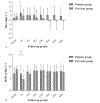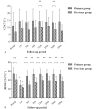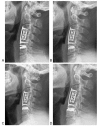Primary cervical disc arthroplasty versus cervical disc arthroplasty adjacent to previous fusion: A retrospective study with 48 months of follow-up
- PMID: 30200065
- PMCID: PMC6133539
- DOI: 10.1097/MD.0000000000011755
Primary cervical disc arthroplasty versus cervical disc arthroplasty adjacent to previous fusion: A retrospective study with 48 months of follow-up
Abstract
The outcomes of cervical disc arthroplasty (CDA) following a previous fusion are ill -defined. The aim of this study was to share our experience and to assess mid-term outcomes in patients receiving CDA adjacent to a previous fusion compared with primary CDA.Patients with cervical radiculopathy and/or myelopathy or patients who had undergone a previous cervical fusion surgery and had developed adjacent segment disease (ASD) between January 2008 and April 2013 were enrolled. Clinical and radiographic outcomes were compared for patients undergoing CDA at a level adjacent to a previous fusion (previous group) and those undergoing primary CDA (primary group).Fifty-two patients in the primary group and 9 patients in the previous group had adequate follow-up data. The mean follow-up periods were 61.96 months and 61.78 months, respectively. The clinical outcomes all significantly improved after surgery, and no significant difference was found between groups. The disc height and range of motion of the operated level were preserved, and the values were similar between groups. Subsidence occurred in 2 (3.8%) patients in the primary group and 1 (11.11%) patient in the previous group. Heterotopic ossification (HO) was detected in 4 (44.44%) patients in the previous group and 18 (34.62%) patients in the primary group. None of the patients required reoperation.Patients treated with a Prestige-LP disc maintained improved clinical outcomes and segmental motion in both the primary and previous groups. Additionally, CDA-treated patients who had a previous fusion surgery could safely undergo the surgery with complication rates similar to that of the first CDA surgery after 48 months of follow-up. CDA adjacent to a previous fusion may be an alternative treatment strategy in the future.
Conflict of interest statement
The authors have no conflicts of interest to disclose.
Figures




References
-
- Eck JC, Humphreys SC, Lim TH, et al. Biomechanical study on the effect of cervical spine fusion on adjacent-level intradiscal pressure and segmental motion. Spine (Phila Pa 1976) 2002;27:2431–4. - PubMed
-
- Hilibrand AS, Carlson GD, Palumbo MA, et al. Radiculopathy and myelopathy at segments adjacent to the site of a previous anterior cervical arthrodesis. J Bone Joint Surg Am 1999;81:519–28. - PubMed
-
- Brodke DS, Zdeblick TA. Modified Smith-Robinson procedure for anterior cervical discectomy and fusion. Spine (Phila Pa 1976) 1992;17(10 suppl):S427–430. - PubMed
-
- Bohlman HH, Emery SE, Goodfellow DB, et al. Robinson anterior cervical discectomy and arthrodesis for cervical radiculopathy. Long-term follow-up of one hundred and twenty-two patients. J Bone Joint Surg Am 1993;75:1298–307. - PubMed
-
- Hilibrand AS, Yoo JU, Carlson GD, et al. The success of anterior cervical arthrodesis adjacent to a previous fusion. Spine 1997;22:1574–9. - PubMed
Publication types
MeSH terms
LinkOut - more resources
Full Text Sources
Other Literature Sources
Medical
Miscellaneous

